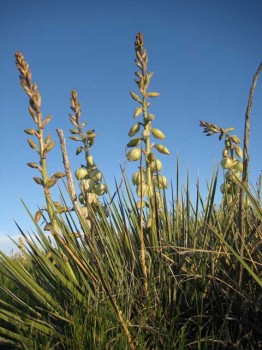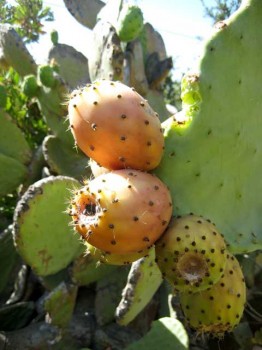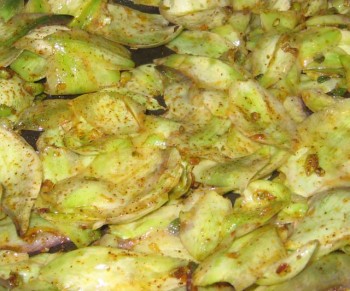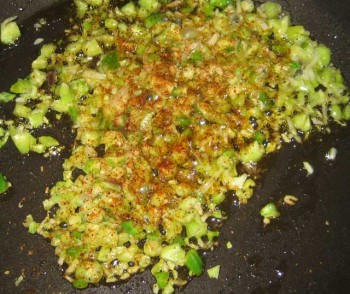
Late last summer, during a whirlwind West Coast visit, I found myself on an unlikely hike through prickly pear cacti up a Malibu mountainside in a private ranch of rented houses to a pool that was clothing-optional on Wednesdays. (Spending time with my friend Reina is always an adventure.)
En route to the pool I tried to pick a prickly pear from atop a cactus in ill-advised bare-handed fashion, only to find that the spines, unlike those of thistle, are quick to release from their fruity bearings and inject themselves into the unlucky plucker’s skin in great numbers. We’re talking 50 spines, give or take. Then, I made the situation even worse by attempting to remove them from my fingers with my teeth, thereupon transferring dozens of sharp hair-like spines from fingers to lips and tongue.
This is not an entry about prickly pear but it sets the stage for a discovery…

Despite some uncertainty about the route and the aforementioned prickly pear incident, Reina and I eventually made our way to the pool, which was set high on the mountainside. There we took a wonderfully refreshing dip, all the while chatting it up with the would-be sunbathers, including the landlord, who while sans clothing was stunningly bedecked with jewels. And now the point of my story: After bemoaning my prickly pear drama, I started preaching about wild edible plants and the conversation made its way to yucca, whereupon this woman shared that her friend’s wife, who is from South America, says that eating yucca flowers is good for lowering a person’s cholesterol!
Could it be so?
This memory occurred to me again yesterday, for the first time in a long time, while I was pondering the whole saponins-in-my-wild-edible plants question. Saponins—contained by both yucca and soapberries—are used as commercial foaming agents. They are soap’s foam. And I wondered: Could the soap from the yucca somehow be cleansing the LDL cholesterol from a person’s system?
I typed “saponins” and “cholesterol” into my Google search box. Lo and behold, up came a bunch of entries about using saponins to lower cholesterol!
“The blood cholesterol-lowering properties of dietary saponins are of particular interest in human nutrition,” writes Peter R. Cheeke, Ph D (1998), citing research by Malinow (1997) that demonstrated their cholesterol-lowering properties. “This desirable effect is achieved by the binding of bile acids and cholesterol by saponins,” Cheeke explains: Saponins deplete cholesterol by preventing reabsorption and increasing its excretion, similar to how cholesterol-lowering drugs like cholestyramine work. Other sources say the data is preliminary, and there is a chance of individual sensitivity and some cases of high toxicity–so it makes sense to proceed with caution, especially in therapeutic doses. In the diet, meanwhile, they might do some real good.

“I like my yucca medicine,” Gregg says, interrupting my reverie as he shoves the last forkful of Southwestern Fried Yucca Flowers into his mouth.
Who knows—maybe they are helping to lower his cholesterol. After all, Gregg’s “bad” LDL cholesterol was 179 last spring out of a total cholesterol of 263—in other words, too high for an exercising man at the ripe young age of 39. So he went on an Isagenix cleanse with stints of yucca flower consumption and continued snowboarding, skateboarding, and hiking. By spring of 2011, Gregg had dropped his total cholesterol to 228 and the “bad” LDL cholesterol to 119. Not great—but not bad, either!
I’m not saying it was necessarily the yucca flowers. Certainly the cleanse may have played a role. (In fact, if you want, Gregg would love to get you on his Isagenix program; email me if interested and I’ll pass your address along.) But what I am saying is that the yucca flowers could have helped.
Southwestern Fried Yucca Flowers

To make Southwestern fried yucca flowers, separate the pistils and stamens from the petals. (Some sources warn against eating the pistils and stamens, but I have seen them used by cooks in regions where related species are traditionally eaten. Up to you.). Finely chop the pistils and stamens and sauté for 10 minutes, sprinkling on a Southwestern seasoning. (I used chipotle and ancho chili powder, salt, pepper, onion, garlic, cayenne red pepper, Mexican oregano, and cilantro). Then add the petals and sauté until bright green, adding more seasoning to taste.
Updated 2.20.21

Are these yucca plants also what Caribbean cultures eat as a root? I’ve had “yucca” prepared boiled and buttery in Dominican and Cuban cuisine. Its a root with a potato-like texture. I just don’t know if its the same plant.
Nope, not the same plant, though it’s a common mistake. As “Green” Deane puts it, “The yucca (YUK-ka) in the wild has several edible parts ABOVE ground. The yuca (YEW-ka) in the grocery store is a cultivated cassava and has one edible part BELOW ground.”
The yucca in this entry is Yucca species. Yuca aka cassava is Manihot esculenta, a different plant altogether. I love both. Cheers:)